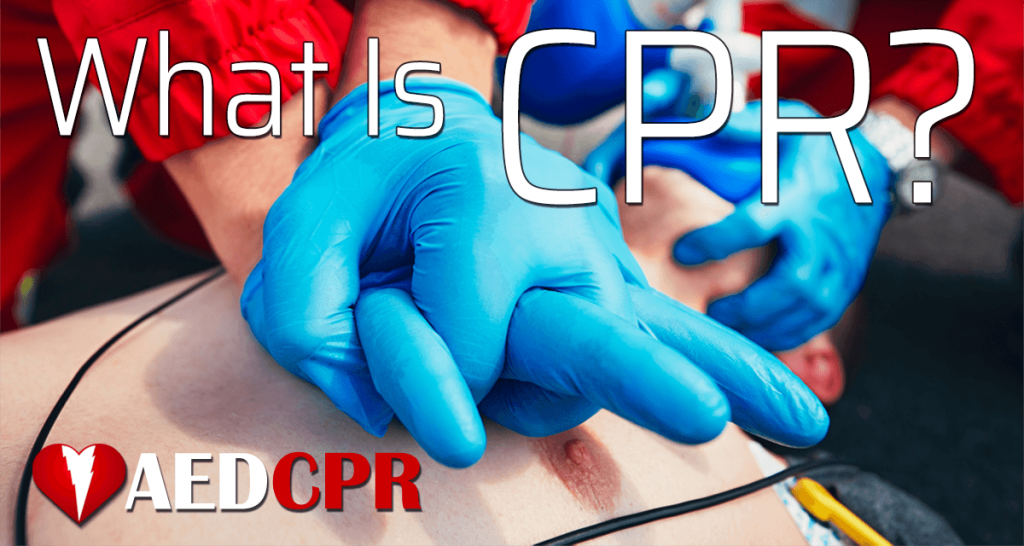
When you think of CPR, you probably think of a doctor or paramedic doing chest compressions on an unconscious person. But you may wonder how CPR actually works as a life saving procedure. What is CPR, and what does CPR do?
CPR Definition
CPR stands for cardiopulmonary resuscitation. It is an emergency procedure for people who are unconscious or unresponsive and whose heart is not beating properly.
When performing CPR, the rescuer performs chest compressions to keep blood flowing in the victim’s body. The motion of the chest compressions can help to pump blood through the body, similar to the way in which the heart pumps blood throughout the body. The blood flow provided by chest compressions can help preserve brain function for a time before the heart is able to function normally again. However, CPR alone is unlikely to restore normal heart function.
In addition to chest compressions, rescuers performing CPR can also provide artificial respiration for victims who have stopped breathing normally. Artificial respiration can be provided by multiple means. Firstly, the rescuer performs mouth-to-mouth resuscitation by blowing air directly into the victim’s lungs and providing oxygen. These ‘rescue breaths’ can be provided by the rescuer ‘blowing’ air into the victim’s mouth, nose, or both as is often the case of infants. However, rescuers should always use PPE when it’s available. For example, rescuers can perform rescue breaths with the help of a CPR mask. Masks such as this can help you safely deliver rescue breaths. These masks create an airtight seal around the victim’s mouth and nose, eliminating the need for you to close the nasal passages with your fingers. Additionally, they have a one-way valve to protect against contamination from the victim.
Using an AED
AED stands for automated external defibrillator. An AED is a portable device that rescuers use on people suffering form cardiac arrest. It is used to convert a pulseless rhythm such as ventricular fibrillation to a normal rhythm that supplies oxygenated blood throughout the body. As mentioned before, the main purpose of CPR is to buy time by preserving brain function. Chest compressions and rescue breaths can help to keep oxygenated blood flowing to the brain. The heart can be made to beat normally again through the use of an AED, which delivers an electric shock that is capable of restoring the heart’s normal beating action. Immediate CPR and defibrillation within 3-5 minutes gives the victim the best chance at survival.
While AEDs are a very important tool for emergency responders, they are also available for public use. Public pools, schools and workplaces will have AEDs handy in an emergency. If you want to know more about AEDs and whether or not they’re right for your home, check out this article.
When Should Someone Use CPR?
Knowing when to perform CPR is critical. After all, the sooner a victim can get emergency care, the better their chances are at recovery. You should perform CPR on a person if they show all of the following signs:
- Unresponsive
- Unconscious
- No pulse or signs of circulation
- Note that lay rescuers may have trouble obtaining a pulse and should check if the victim shows signs of impaired circulation. For instance, color changes, pale skin, and decreased body temperature.
Conversely, you should not perform CPR on a person who shows signs of life. For example, someone who is alert or talking.
Since the purpose of CPR is to preserve heart and brain function by maintaining blood flow, chest compressions are not necessary if the victim has a normal and easily detectable heartbeat or signs of circulation.
When Should Someone Perform Rescue Breaths?
Rescue breaths should be provided to victims who have a pulse but are not breathing adequately. It’s not always appropriate to perform rescue breaths while performing CPR. The American Heart Association advises untrained rescuers to avoid using rescue breaths and stick to uninterrupted chest compressions instead. The same goes for people with CPR training who are out of practice. You should only perform rescue breaths if you are confident and ready. If you can’t perform rescue breaths properly, you will be more help to the victim by just focusing on chest compressions.
What is a Cardiac Arrest?
Cardiac arrest is a medical emergency that requires immediate treatment. It is caused by a disturbance in the heart’s normal electrical activity, which causes the heart to stop pumping blood correctly. As a result, the brain and other organs stop receiving oxygenated blood.
Cardiac Arrest occurs abruptly. Brain damage and death can occur within minutes of onset. Cardiac Arrest is characterized by the following symptoms:
- Sudden collapse
- Unconsciousness
- Lack of breathing
- Lack of heartbeat
What causes Cardiac Arrest?
Cardiac arrest can have multiple causes. The majority of cases are the result of heart disease in some form or another. The usual culprits of smoking, high blood pressure, and high cholesterol can damage the heart and arteries. The damage done makes the heart more susceptible to sudden cardiac arrest.
There are other causes that rescuers need to be aware of. For example, a person can go into cardiac arrest, if they experience dangerously high or low blood sugar, or overdose on a drug. In these instances, performing CPR may not be enough without also treating the cause. Formal training for CPR in first aid can help to prepare for such situations.
Take note: cardiac arrest and a heart attack are not the same thing. Though a heart attack can lead to cardiac arrest, CPR is not suitable for someone having a heart attack who is alert and awake. You can learn more about the difference between a heart attack and cardiac arrest here.
What is CPR Training?
CPR training is mandatory for doctors, nurses, emergency response personnel, and much more. Many professions require employees to undergo CPR training for their job. CPR training can be taught in a classroom or entirely online from a nationally accredited organization.
CPR classes cover the essential materials a rescuer needs to know. That includes how to perform CPR, rescue breaths, how to use an automated external defibrillator (AED) and more. Also, there are different levels of CPR classes. CPR can be taught alone, as part of a First Aid course, or as part of classes on Basic Life Support for Healthcare Providers.
Where Do CPR Guidelines Come From?
The original guidelines for CPR published in 1966. Specifically, the guidelines were originally decided by a Committee on Cardiopulmonary Resuscitation assembled at a conference on CPR at the National Academy of Sciences-National Research Council. The committee decided on the guidelines in order to standardize the procedure. They formed the committee to create these guidelines in response to pressure from national organizations like the American Red Cross. The committee established how responders would perform CPR.
Today, the American Heart Association periodically reviews and updates the guidelines for CPR. The AHA updates the guidelines for performing and teaching CPR as needed based on evidence. Today, rescuers and teachers are all taught CPR in accordance with the AHA guidelines. Rescuers must periodically update their certification in part because of the fact that the AHA guidelines are changed to reflect new evidence and techniques.
How to Perform CPR
CPR can be performed by anybody, even those without formal training. If you see another person go into cardiac arrest, you can help them by administering CPR. However, before you perform CPR, there are a few steps to follow.
Before CPR
- Make sure that the scene is safe.
- Check to see if the victim is responsive. If they are, then CPR is not appropriate.
- If possible, have another person call (911) for an ambulance while you perform CPR. In the event that nobody else is available, call (911) yourself before continuing.
- Lay the victim on their back, and tilt their head back slightly by lifting their chin. Check for signs of breathing (Coughing or sputtering is not normal breathing in this case). Look, listen and feel for signs of breathing and circulation.
To Perform CPR on an Adult
Once you’ve determined that the scene is safe, have called for an ambulance, and have determined there are no signs of circulation, you can begin administering CPR. To do that:
- Give chest compressions. Place your hands one over the other on the middle of the victim’s chest. Push down on the victim’s chest about 2 inches deep, using your body weight if needed. Perform these motions at a rate of at least 100 compressions per minute.
- Give rescue breaths. Put your mouth over the victim’s and pinch their nose closed. Blow air into their mouth to make their chest rise. Perform two rescue breaths before continuing with chest compressions.
- If the chest does does not rise while performing the rescue breaths, the victim may be choking. If so, turn their head and check for anything blocking their airway between sets of compressions and rescue breaths.
- Continue to cycle between chest compressions and rescue breaths. Perform 30 chest compressions, then 2 rescue breaths, and repeat until help arrives.
Once again, note that if you are not confident in your ability to give rescue breaths, don’t perform them. Stick to chest compressions.
To Perform CPR on a Child
Performing CPR on a child is similar to an adult. One important note is that the main cause of cardiac arrest in children is respiratory failure or shock, rather than arrhythmia as seen in adults.
If you suspect respiratory failure in a child, call (911) and give 2 rescue breaths. If the child does not respond to the rescue breaths, begin CPR:
- Place the heel of your hand on the child’s chest, and place your other hand on top of that, interlocking the fingers.
- Deliver 30 chest compressions 2 inches deep,
- Give 2 rescue breaths.
- Repeat until help arrives or until child begins breathing again.
What is Cardiopulmonary Resuscitation
In summary, CPR is an important life-saving technique that is used for people whose hearts have stopped. If administered quickly enough, it can help save lives. Medical professionals are required and expected to be able to give CPR, but it is a very useful skill that everyone who is able should know.
